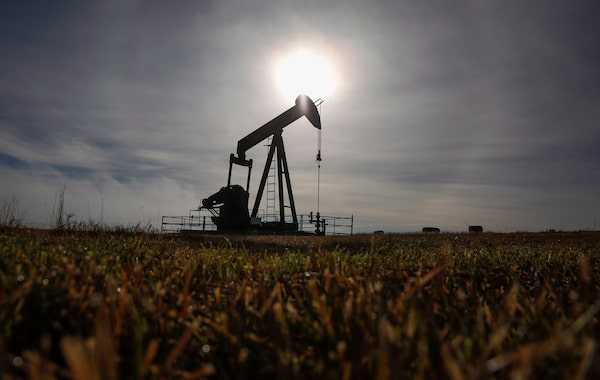
A pumpjack works at a well head on an oil and gas installation near Cremona, Alta., in this file photo from Oct. 29, 2016. Alberta is tightening its methane regulations, bringing it closer to controlling emissions from greenhouse gases, contingent on a review from Ottawa to ensure they meet federally mandated targets.Jeff McIntosh
Alberta is tightening its methane regulations, bringing it closer to controlling emissions from the greenhouse gas, contingent on a review from Ottawa to ensure they meet federally mandated targets.
The province released updated regulations on Tuesday that Alberta expects will bring it into line with Ottawa’s minimum standards to grant a province oversight of the emissions from its oil and gas sector. Methane is a potent greenhouse gas, making it a key part of Ottawa’s climate change plans.
The changes appear to end a years-long tussle over the regulations. Alberta has said a misunderstanding of its modelling was to blame for Ottawa believing the regulations fell short, while the federal government said substantive changes were needed to bring the regulations up to standard. Ottawa’s goal is to cut methane emissions from the oil and gas sector by 40 to 45 per cent from 2012 levels by 2025.
Following “aggressive negotiations," provincial Environment Minister Jason Nixon said the two governments reached a preliminary equivalency agreement. A federal government source said Ottawa has pre-vetted the changes to the regulations but it will still need to review them before striking a deal. Once confirmed, the equivalency agreement will be subject to a 60-day consultation period.
The regulations will meet Ottawa’s 2025 target and cost industry less, Mr. Nixon said, as he played down the changes released Tuesday, saying there was “nothing of significance" but rather “minor changes.”
Federal Environment Minister Jonathan Wilkinson called the months of negotiations between Ottawa and Edmonton “collaborative and constructive,” adding Alberta agreed to a host of changes that bring the provincial regulations in line with federal requirements.
Federal and provincial regulations have both been in effect since Jan. 1. While the two governments hammered out the deal, Ottawa had allowed companies to only register under the provincial program to avoid duplication.
“It didn’t make any sense to have two different methane regulations standing side by side, so I’m very pleased with the work,” Mr. Wilkinson said.
“We wouldn’t take it through the regulatory process if we didn’t believe that Alberta had moved to the point where we think that it is equivalent, but we obviously need to get public input and we need to go through the internal approval processes.”
If feedback results in issues or challenges neither government had considered, he said, “we’ve told Alberta we’ll loop them back and have more conversations.”
Mr. Wilkinson said stumbling blocks during negotiations included technical disagreements over testing and monitoring emissions.
“While Minister Nixon and I don’t always agree on everything, he’s a person I take at his word and he is somebody who has been committed to getting this done. I think that’s an important part of us being able to push this over the line,” Mr. Wilkinson said.
Similar wrangling happened around equivalency agreements on methane regulations in Saskatchewan and British Columbia, he said, “and we found a pathway that makes sense” for both the environment and specific provincial needs.
Alberta’s new methane rules come less than a month after Ottawa rolled out a $750-million fund to help oil and gas companies cut emissions of the potent greenhouse gas. It follows in the footsteps of similar deals reached with B.C. and Saskatchewan.
Alberta’s new regulations include changes to measuring and monitoring methane emissions. For example, the provincial government says it will now test emissions from single-well batteries for a 72-hour period, rather than 24 hours. An exemption for pneumatic devices has also been removed, so that all of that equipment must prevent or control venting (unless for a safety reason).
An equivalency agreement was one of Alberta Premier Jason Kenney’s main requests during his trip to Ottawa in late 2019.
Jan Gorski, senior analyst at the Pembina Institute, said the think tank looks forward to seeing the improvements Alberta has made to its methane regulations to meet federal obligations.
"We also believe there’s an opportunity for Western Canada to go beyond the current methane targets and demonstrate global leadership, which will help improve the competitiveness of the oil and gas sector," he said.
Mr. Gorski said he would also like more transparency from the Alberta government around improvements to methane regulations and the steps it has taken towards equivalency.
Releasing methane directly into the atmosphere is worse for climate change than end-use combustion because when the gas is burned, it turns into less harmful carbon dioxide. As the principal component of natural gas, methane is highly valuable and so limiting leaks is also viewed as a cost-effective way to cut greenhouse-gas emissions.
Tim McMillan, president and chief executive of the Canadian Association of Petroleum Producers, said in a statement the regulatory change was “good news” for Alberta’s oil and gas producers.
"The provincial framework supports a flexible, results-oriented approach to reducing emissions while stimulating technology and innovation essential to meeting our environmental performance goals at this critical time," he said.
In March, the industry group asked the federal government to suspend, delay or reconsider regulatory actions that would add costs to industry, citing the COVID-19 pandemic.
We have a weekly Western Canada newsletter written by our B.C. and Alberta bureau chiefs, providing a comprehensive package of the news you need to know about the region and its place in the issues facing Canada. Sign up today.
 Marieke Walsh
Marieke Walsh Emma Graney
Emma Graney